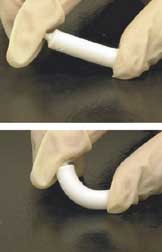
Photo from wikipedia
In order to explore novel synthetic bone scaffolds as part of our ongoing research in the field of bone tissue engineering, we have synthesized a biomimmetic, osteoinductive, tricomposite scaffold incorporating… Click to show full abstract
In order to explore novel synthetic bone scaffolds as part of our ongoing research in the field of bone tissue engineering, we have synthesized a biomimmetic, osteoinductive, tricomposite scaffold incorporating Euryale ferox (EF) with nano-hydroxyapatite and chitosan. The surface morphology of the resultant nanocomposite was visualized via SEM and TEM studies which exhibited a rougher surface of n-HA/CS/EF compared to the n-HA/CS nanocomposite with the particle size ranging between 15 and 20 nm. The n-HA/CS/EF scaffold was degraded up to (16.9 ± 0.70)% in contrast to degradation of (7.4 ± 0.2)% for n-HA/CS. The in vitro SBF study exhibited excellent biomineralization capacity for n-HA/CS/EF which was further elucidated using the ARS staining procedure. The MTT assay illustrated significantly better cell viability compared to the n-HA/CS nanocomposite. A comparatively better antibacterial activity of n-HA/CS/EF was observed against a number of bacterial pathogens. The osteogenic differentiation test (ALP assay) assessed the osteoconductivity of the n-HA/CS/EF nanocomposite. Thus, the synthesized scaffold can be envisioned for potential use in reparation of bone defects.
Journal Title: New Journal of Chemistry
Year Published: 2018
Link to full text (if available)
Share on Social Media: Sign Up to like & get
recommendations!